Chapter 4 Kingdom Animalia
1. Choose the correct option
Question (A)
Which of the following belongs to a minor phylum?
(a) Comb jelly
(b) Jellyfish
(c) Herdmania
(d) Salpa
Answer:
(a) Comb jelly
Question (B)
Select the animal having venous heart.
(a) Crocodile
(b) Salamander
(c) Rohu
(d) Toad
Answer:
(c) Rohu
Question (C)
In Ascaris, _______ .
(a) mesoglea is present
(b) endoderm is a discontinuous layer
(c) mesoderm is present in patches
(d) body cavity is absent
Answer:
(c) mesoderm is present in patches
Question (D)
Which of the following is INCORRECT in case of birds?
(a) Presence of teeth
(b) Presence of scales
(c) Nucleated RBCs
(d) Hollow bones
Answer:
(a) Presence of teeth
Question (E)
Chitinous exoskeleton is a characteristic of ________ .
(a) Dentalium
(b) Antedon
(c) Millipede
(d) Sea urchin
Answer:
(c) Millipede
2. Answer the following questions.
Question (A)
Reptiles are known for having three chambered heart. Which animal shows a near four chambered condition in reptiles?
Answer:
Crocodiles have a four chambered heart.
Question (B)
The circulatory system has evolved from open to closed type in Animal Kingdom. Which Phylum can be called first to represent closed circulation?
Answer:
Phylum Annelida is the first phylum to represent closed circulation.
Question (C)
Pinna is part of external ear and it is found in mammals. Do Aves and Reptiles show external ear in any form?
Answer:
No, Aves and Reptiles do not show external ear in any form. They possess tympanum which represents the ear.
Question (D)
Fish and frog can respire in water. Can they respire through their skin? If yes, why do they have gills?
Answer:
1. Yes, fishes and frogs can respire through their skin.
2. The larval stage of frog i. e. tadpole respires through gills. During metamorphosis, tadpoles lose their gills and develop lungs.
3. Frogs do not have scales and breathe through their skin underwater.
4. Fishes respire primarily via gills. The body of fishes is covered with scales which limits cutaneous respiration in them.
Question (E)
Birds need to keep their body light to help in flying. Hence, they show presence of some organs only on one side. How their skeleton helps in reducing their weight?
Answer:
- In birds, the forelimbs are modified into wings for flying.
- They possess stream-lined body to reduce resistance during flight.
- Bones are hollow or pneumatic to reduce body weight.
- In order to reduce body weight, urinary bladder is absent. Also, females possess only left ovary and oviduct.
- Body is covered by feathers to facilitate flying.
Question (F)
Cnidarians and Ctenophorans are both diploblastic. Which other character do they have in common, which is not found in other phyla?
Answer:
Cnidarians and ctenophorans show tissue level of body organization. They have blind sac body plan and radially symmetrical body.
Question (G)
Crab and Snail both have a protective covering. Is it made up of the same material?
Answer:
No, the protective covering is not made up of same material in crab and snail. The protective covering of crabs is made up of chitin and that of snails is made up of calcium carbonate.
Question (H)
Sponge and sea star show calcareous protective material. Do they belong to the same Phylum?
Answer:
No, they do not belong to same phylum. Sponges belong to phylum Porifera and sea star belongs to phylum Echinodermata.
1. Adult echinoderms are radially symmetrical but larval forms are bilaterally symmetrical.
2. Larvae of echinoderms are free-swimming.
Question (I)
Fish and snake both have scales. How do these scales differ from each other?
Answer:
Fishes have dermal scales covering the body surface whereas snakes have epidermal scales or scutes.
Question (J)
Lower Phyla like Arthropods and Cnidarians show metamorphosis. Is it also found in any class of Phylum Chordata?
Answer:
Yes, it is also found in class Amphibia of phylum Chordata.
Question 3.
Draw neat labelled diagram.
A. Sycon
B. Aurelia
C. Amphioxus
D. Catla
E. Balanoglossus
F. Scolidon
Answer:
A. Sycon

B. Aurelia
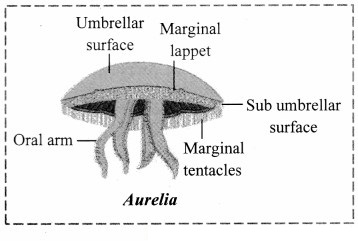
C. Amphioxus
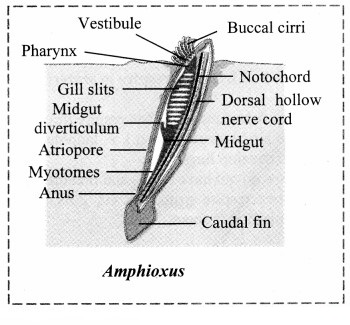
D. Catla
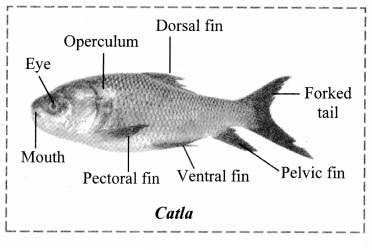
E. Balanoglossus
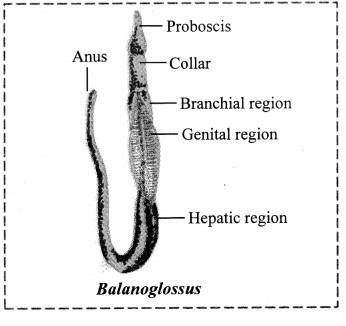
F. Scolidon

Question 4.
Match the following.
Phylum | Characters |
1. Annelida | (a) Tube feet |
2. Mollusca | (b) Ostia |
3. Ctenophora | (c) Radula |
4. Porifera | (d) Parapodia |
5. Echinodermata | (e) Comb plates |
Answer:
Phylum | Characters |
1. Annelida | (d) Parapodia |
2. Mollusca | (c) Radula |
3. Ctenophora | (e) Comb plates |
4. Porifera | (b) Ostia |
5. Echinodermata | (a) Tube feet |
5. Identify the animals given in pictures and write features of its phylum/class.
Question 1.
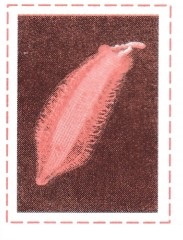
Answer:
The organism in the given picture is Comb jelly (Red midwater Comb jelly) and it belongs to phylum Ctenophora.
Question 2.
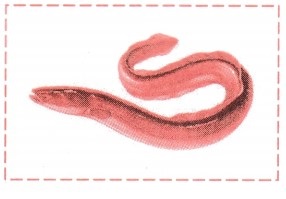
Answer:
The organism in the given picture is Eel and it belongs to phylum Chordata.
Question 3.
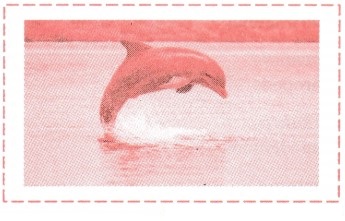
Answer:
The given organism in the given picture is Dolphin and it belongs to class Mammalia.
Question 4.
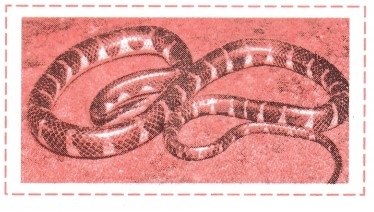
Answer:
The given organism is Snake and it belongs to class Reptilia
Question 5.
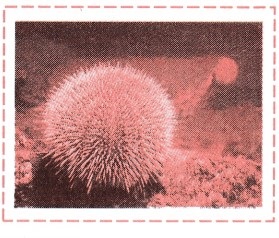
Answer:
The given organism is Sea urchin and belongs to phylum Echinodermata.
Question 6.

Answer:
The given organism is flying lizard and belongs to class Reptilia.
Question 7.
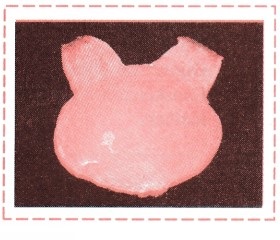
Answer:
The organism is Herdmania and belongs to Phylum Chordata (Subphylum Urochordata).
Question 8.
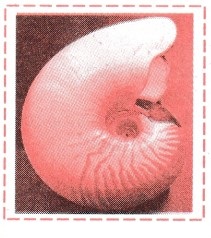
Answer:
The organism in the given picture is Nautilus and it belongs to phylum Mollusca.
Question 9.
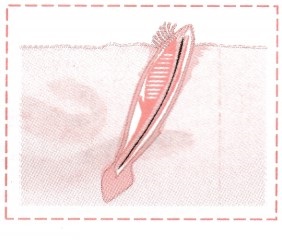
Answer:
The organism in the given picture is Amphioxus and it belongs to Phylum Chordata (Subphylum Cephalochordata).
6. Observe and identify body symmetry of given animals.
Question 1.
Observe and identify body symmetry of given animals.
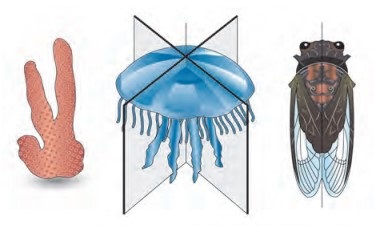
Answer:
Fig i. represents asymmetry
Fig ii. represents radial symmetry
Fig iii. represents bilateral symmetry
Practical/Project:
Question 1.
Study different animals in kingdom Animalia and prepare the chart with detail scientific information.
Answer:
Phylum Porifera (Pori = Pores: feron = bearing): Members of the phylum Porifera are also called sponges. Characteristic features of the phylum:
- Habitat: They are aquatic, mostly marine but few species are found in fresh water.
- Forms: They are sedentary animals (attached to substratum or rock).
-
Body shape: They have asymmetrical body. Body of these animals consists of many cells with minimal
division of labour among cells. Hence, their body is considered as a colony of different types of cells. - Body surface: Their body bears minute pores called ‘ostia’ through which water enters the spongocoel (body cavity). Water leaves the body through a large opening called ‘osculum’. Beating of flagella creates water current.
- Circulation: Water is circulated in the body through the ‘canal system’. When the water enters the body of poriferans, cells absorb the food, exchange respiratory gases and release excretory products.
- Digestive system: The body cavity of sponges (spongocoel) is lined by unique type of flagellated cells called choanocytes or collar cells for digestion.
- Endoskeleton: The body of sponges consists of calcareous / siliceous spicules and proteinaceous ‘spongin fibres’.
- Reproduction: Sponges reproduce asexually as well as sexually. Asexual reproduction takes place by fragmentation and gemmule formation. Sexual reproduction is by formation of gametes. Fertilization is internal and development is indirect through larval stage.
-
Sponges have great power of regeneration.
e.g. Scypha, Euspongia (Bath sponge), Euplectella (Venus’ flower basket).
Characteristics of members belonging to phylum Cnidaria:
- Habitat: They are aquatic, mostly marine and few of them are fresh – water forms.
- Forms: They are sessile or free swimming.
- Cnidoblasts: Presence of cnidoblasts or stinging cells are present on the tentacles for anchorage, offence and defence.
- Body Symmetry: They have radially symmetrical body.
- Germ layer: They are diploblastic.
- Body cavity: Cnidarians have a central cavity called coelenteron or gastrovascular cavity, which helps in digestion and circulation. They have blind-sac body plan i.e., single pore opening to the exterior in the digestive system.
- Body form: Members of this phylum exhibit two body forms. The cylindrical form, known as polyp e.g. Hydra and the umbrella – like form (.Aurelia – jelly fish) is known as medusa.
- Digestion: They have extracellular and intracellular digestion.
- Reproduction: Cnidarians reproduce asexually and sexually.
Asexual reproduction takes place by budding and regeneration. Sexual reproduction takes place gamete formation. They exhibit metagenesis i.e. alternation of polypoid generation with medusoid generation. Polyps produce medusae asexually and medusae produce polyps sexually, e.g. Obelia
e.g. Hydra, Aurelia (Jellyfish), Physalia (Portuguese man-of-war), Adamsia (Sea anemone), Diploria (Brain coral), Gorgonia (sea fan).
The members of this phylum are commonly known as comb jellies and sea walnuts. They are also known as acnidarians as they lack cnidoblasts. The phylum is considered as one of the minor phyla as it is represented by very few members.
Salient features of phylum Ctenophora:
- Habitat: They are exclusively marine.
- Forms: They are free swimming animals.
- Germ layers: Members of this phylum are diploblastic.
- Body Symmetry: They are radially symmetrical.
- Body plan: The animals of this phylum show blind-sac body plan.
- Body organization: They show tissue level organization.
- Locomotion: It is earned out by eight rows of ciliated comb plates.
- Bioluminescence: It is the characteristic feature of the members of this phylum.
- Digestion: It is extracellular and intracellular.
- Reproduction: Reproduction is sexual with indirect development.
- Colloblasts: These sticky cells are used to capture prey, e.g. Pleurobrachia, Ctenoplana
Intext Questions and Answers
Can you recall? (Textbook Page No. 29)
(i) What is the basis for classification?
Answer:
Grades of organization, body symmetry, body cavity, germ layers and segmentation form the basis for classification.
(ii) Who proposed Five kingdom classification system?
Answer:
Robert Whittaker proposed the five kingdom system of classification.
(iii) What is the need and importance of classification?
Answer:
Need and importance for classification:
a. Classification facilitates the identification of animals with great accuracy.
b. The study of animals becomes convenient.
c. It helps in understanding the relationship of animals with other living organisms.
d. It helps to understand the habitat of each animal along with its role in nature.
e. By studying few animals from a group, we can gain a better understanding about the entire group.
f. It helps in understanding different adaptations shown by animals.
g. It gives an idea about evolution of animals.
Observe and discuss. (Textbook Page No. 29)
Discuss the criteria of classification.
Answer:
1. The given diagrams represents the number of germ layers and body symmetry used as criteria for animal classification.
2. Number of germ layers:
(a) When an organism shows only two germ layers, they are called diploblastic animals. In this case, the outer ectoderm is separated from the inner endoderm by a non-living substance called mesoglea.
(b) When an organism shows three germinal layers, they are called triploblastic animals. The three layers are namely – outer ectoderm, middle mesoderm and inner endoderm.
3. Body symmetry:
Body symmetry implies to the similarity in shape, size and number of parts on the opposite sides of a median line when body is divided into two halves by an imaginary line along different plane. Animals may be asymmetrical, radially symmetrical or bilaterally symmetrical.
(a) Asymmetrical animals:
An animal is said to be asymmetrical when its body cannot be divided into two identical halves in any plane.
(b) Radially symmetrical animals:
In certain animals, body can be cut or divided into two similar halves in a number of planes wherein, all the cuts (planes) pass through the centre. This type of symmetry is called radial symmetry.
(c) Bilaterally symmetrical animals:
In this type, the body of the animal can be bisected or divided in two equal or identical halves by a single median or vertical plane.
Internet my friend. (Textbook Page No. 30)
Which are the larval stages of Porifera.
Answer:
Larval stages of Porifera:
Parenchymula – Flagellate larvae of calcinean sponges
Amphiblastula – Free swimming larval stage of Sycon and many other calcareous sponges. Rhagon— Larval stage which give rise to the leuconoid condition in demospongiae.
[Students are expected to find more information about the larval stages of Porifera on internet.]
Find out. (Textbook Page No. 31)
Information about coral reefs and sea fan.
Answer:
Coral reefs:
- A coral reef is an underwater ecosystem characterized by reef building corals.
- Coral reefs constitute 25% of all marine species on the planet.
- They belong to phylum Cnidaria.
- There are three main types of coral reefs – fringing, barrier and atoll. Coral reefs provide ecosystem services for tourism, fisheries and shoreline protection.
- They cannot survive in high temperatures, thus due to climate change there is a sharp decline in their population.
Sea fan or Gorgonia:
1. It is a soft coral composed of numerous polyps – cylindrical, sessile (attached) forms that grow together in a flat, fan-like pattern.
2. It belongs to phylum Cnidaria.
3. It does not produce calcium carbonate skeletons.
[Students can find out more information about coral reefs and sea fan using internet ]
Can you tell? (Textbook Page No. 32)
(i) State the parasitic adaptations in Liver fluke and Ascaris.
Answer:
Parasitic adaptations in Liver fluke:
a. Presence of hooks and suckers
b. Body covered with cuticle
c. Lacks digestive system
d. They are hermaphrodites
Parasitic adaptations in Ascaris:
a. Presence of muscular pharynx for sucking the food.
b. Body covered by tough, thick and resistant cuticle.
c. Secretes enzymes against the enzymes secreted by the host.
d. Respiration is anaerobic.
e. Reproductive system is highly developed.
(ii) Give example of free living platyhelminth.
Answer:
Planaria
Find out. (Textbook Page No. 33)
What are the merits and demerits of hermaphroditism?
Answer:
Hermaphroditism is the condition in which an organism possesses reproductive organs of both the sexes.
Merits of hermaphroditism:
a. Assured fertilization which reduces the risk of a species to become extinct due to unavailability of mating partner.
b. Energy required for searching out mating partner is conserved.
c. Frequency of mating is maximized.
Demerits of hermaphroditism:
a. More energy is required to maintain both the reproductive systems.
b. Limited gene diversity.
[Source: http://floydbiology. blogspot. com/2012/06/httpmattc-thinks. html]
[Students are expected to find more information using the internet.]
Why are leeches used in Ayurveda?
Answer:
a. Leeches are used in blood purification therapy to treat many diseases as they suck impure blood from the affected site of the patient’s body.
b. The anticoagulant – hirudin present in saliva of leech, inhibits the coagulation of blood and makes blood thinner. This dissolves the clots found in vessels and facilitates the blood supply.
What is the role of earthworms in agriculture? What is vermicompost?
Answer:
Role of earthworms in agriculture:
a. Earthworms loosen the soil by burrowing deep into it, thus they help to aerate the soil.
b. This continuous digging of soil also helps the water to reach the roots quickly.
c. Earthworms can decompose the organic matter from the soil and convert it into rich manure.
d. This helps in increasing the fertility of soil which ultimately increases the crop production.
e. Earthworm castings are rich in nutrients which act as natural fertilizer.
Vermicompost:
Vermicompost is the product of vermicomposting. It is organic manure produced as vermicast by earthworm feeding on biological waste material and plant residues.
Can you tell? (Textbook Page No. 34)
(i) Explain the term metameric segmentation.
Answer:
In some animals, body consists of many segments arranged along the length of the body. When the external segmentation coincides with the internal segmentation, it is called as metameric segmentation and the phenomenon is called metamerism.
(ii) Give characteristics of Arthropoda.
Answer:
Arthropoda (Arthros: Joint, Podos: leg): Arthropoda forms the largest phylum of kingdom Animalia. Characteristics of Arthropoda:
a. Habitat: Arthropods are omnipresent.
b. Forms: Solitary or colonial, most of them are free-living. Barnacles are sedentary. Few are parasitic and sanguivorous, (e.g. Female mosquito, bed bug.)
c. Body symmetry: Body is bilaterally symmetrical.
d. Germ layers: They are triploblastic.
e. Body cavity: Arthropods are eucoelomates.
f. Body plan: They show tube within tube body plan.
g. Level of body organization: They show organ system level of organization.
h. Special features: The members of this phylum have jointed appendages. Hence, they are known as arthropods. Some insects like honey bee, ants, termites, etc. exhibit polymorphism.
i. Exoskeleton: Body is covered by a tough, non – living chitinous exoskeleton. As the exoskeleton does not allow body growth, arthropods shed off their exoskeleton periodically during growth. This process is called moulting or ecdysis.
j. Body division: Body is divided into head, thorax and abdomen.
k. Segmentation: Body shows metameric segmentation.
l. Digestion: Digestive system is complete and divided into foregut, midgut and hindgut.
m. Circulation: Circulatory system is of open type wherein, blood flows through body cavity called haemocoel.
n. Respiration: Respiration occurs through respiratory organs like gills, trachea, book lungs or book
gills.
o. Excretion: Excretion takes place by green glands, Malpighian tubules or coxal glands.
p. Nervous system: Nervous system consists of nerve ring and double, ventral ganglionated nerve cord.
q. Sense organs:Arthropods have well developed sense organs in the form of antennae, simple or compound eye and various receptors.
r. Sexual reproduction: Sexes are generally separate in arthropods with distinct sexual dimorphism.
s. Significance:
Beneficial arthropods: Some arthropods are of economic importance. For example, Honey bees (Apis) are important for their honey and wax, silk worms for the production of silk. Lobsters, prawns, crabs are edible. Harmful arthropods: Some arthropods are harmful and act as vectors to spread various diseases, e.g., Mosquitoes. Locusta (locust) is a gregarious pest. Limulus (King crab) is a living fossil.
Other examples: Cockroach (Periplaneta), butterfly, scorpion (Hottentotta) and millipede (Archispirostreptus) prawn.
(iii) Enlist the harmful Arthropods.
Answer:
Significance:
Beneficial arthropods: Some arthropods are of economic importance. For example, Honey bees (Apis) are important for their honey and wax, silkworms for the production of silk. Lobsters, prawns, crabs are edible. Harmful arthropods: Some arthropods are harmful and act as vectors to spread various diseases, e.g., Mosquitoes. Locusta (locust) is a gregarious pest. Limulus (King crab) is a living fossil.
Other examples: Cockroach (Periplaneta), butterfly, scorpion (Hottentotta) and millipede (Archispirostreptus) prawn.
Find out. (Textbook Page No. 34)
(i) Why is phylum Arthropoda considered as most successful phylum?
Answer:
Phylum Arthropoda is considered as most successful phylum because of the following reasons:
a. Phylum Arthropoda is the largest phylum of kingdom Animalia. It includes various forms like lobsters, prawns, crabs, insects, millipedes, locust, honeybees, etc.
b. They are omnipresent (present everywhere). Arthropods show great variety of adaptations as their habitat varies from terrestrial to aquatic habitat.
c. Several others factors also contribute to the success of the phylum which includes:
1. The exoskeleton of arthropods is made up of tough chitinous exoskeleton. This enables them to survive on lands in almost all environment and is a great defense against predators.
2. They possess jointed appendages which allow complex movements.
3. They exhibit moulting or eedysis.
4. They have metamerically segmented body helping in movement around diverse environments.
(ii) What do we mean by parthenogenesis?
Answer:
Development of an egg into a complete individual without fertilization is known parthenogenesis. It is found in many non-vertebrates such as bees, rotifers and even some lizards and birds (turkey).
(iii) What do we mean by living fossil?
Answer:
A member of a living animal or plant species that is almost identical to species known from the fossil record (not the recent fossil record), i.e. they have changed very little over a long period.
[Source:https://www. encyclopedia, com/earth-and-environment/ecology-and- environmentalism/environmental-studies/living-fossil]
(iv) How the bees produce honey?
Answer:
a. Bees produce honey using the nectar of flowering plants. A bee sucks the nectar and stores it in a honey sac until it returns to the hive.
b. The nectar is then transferred to worker bees in the hive who suck the nectar from the honey sac through their proboscis. This nectar contains 70% water and 20% honey. Honeybees get rid of excess water by swallowing and regurgitating the nectar again and again. They also fan their wings over filled cells of honeycomb.
When most of the water has evaporated from the honeycomb, the bee seals the comb with a secretion of liquid from its abdomen which eventually hardens into beeswax. This is how the honey bees use nectar to produce a thick, sticky and sweet honey.
(v) What will happen if arthropods do not moult?
Answer:
a. Moulting or eedysis is a periodic shedding of the outer cuticle layer of body in arthropods.
b. The outer layer of body of arthropods is formed of tough, non-living chitinous substance.
c. If arthropods do not moult, they cannot grow and mature into adult forms
Can you tell? (Textbook Page No. 34)
Why do Molluscs have shell?
Answer:
Molluscs are soft-bodied animals. Thus, the calcareous shell provides supports and protects the organisms from predators.
Can you tell? (Textbook Page No. 36)
Give salient features of phylum Echinodermata.
Answer:
Salient features of phylum Echinodermata (Echinus – spines, derma – skin)
- Habitat: These are exclusively marine.
- Forms: Members of this phylum are solitary, sedentary or free-living and gregarious, benthic.
- Body symmetry: These animals are radially symmetrical with pentamerous symmetry.
- Shape: Members of Echinodermata are spherical, elongated or star-shaped.
- Body: The endoskeleton is made up of calcareous ossicles. Spines are formed on the body. Hence, they are known as echinoderms. The body has two sides oral and aboral and lacks definite divisions. Mouth is ventrally present on oral surface and anus on aboral surface.
- Water vascular system: Presence of water vascular system is the peculiar character of echinoderms. The madrepOrite is the opening of water vascular system through which water enters. Water vascular system is useful in locomotion, food capturing, respiration.
- Digestion: Digestive system is complete.
- Respiration: Peristomial gills, papillae, respiratory tree, etc. are used for respiration.
- Circulatory and excretory systems: Absent in echinoderms.
- Nervous system: Nervous system is simple with a nerve ring around the mouth and radial nerves in arms.
- Reproduction and development: Sexes are separate (sometimes bisexual). Fertilization is external.
- Development is indirect, i.e. through larval stages. They show high power of regeneration.
e.g. Sea lily (Antedon), Sea star (Asterias), Sea cucumber (Cucumaria), Brittle star (Ophiothrix), Sea urchin (Echinus).
Can you tell? (Textbook Page No. 36)
Can you tell? (Textbook Page No. 36)
Answer:
1. Hemiehordata was earlier considered as sub phylum of Chordata because the buccal diverticulum was considered as notochord. It is now placed as a separate phylum under Non-Chordata.
2. It possesses certain characteristics of both Chordates and Non-chordates.
3. Absence of notochord worm-like body, heart located on the dorsal side are the Non-chordate like characteristics seen in Hemiehordata.
4. Presence of nerve chord, pharyngeal gill slits are some of the Chordate-like characters seen in Hemiehordata. Hence, Hemiehordata is considered as a connecting link between Non-chordata and Chordata.
Find out. (Textbook Page No. 36)
Why Balanoglossus is considered as connecting link between Non-chordates and chordates?
Answer:
Balanoglossus belongs to phylum Hemiehordata. For Explanation:
- Hemiehordata was earlier considered as sub phylum of Chordata because the buccal diverticulum was considered as notochord. It is now placed as a separate phylum under Non-Chordata.
- It possesses certain characteristics of both Chordates and Non-chordates.
- Absence of notochord worm-like body, heart located on the dorsal side are the Non-chordate like characteristics seen in Hemiehordata.
- Presence of nerve chord, pharyngeal gill slits are some of the Chordate-like characters seen in Hemiehordata. Hence, Hemiehordata is considered as a connecting link between Non-chordata and Chordata.
Observe and discuss. (Textbook Page No. 36)
Compare and contrast between Non-Chordates and Chordates.

Answer:
Non-chordates | enoraates |
1. Notochord is absent. | Notochord present at least in the early embryonic life. |
2. Nerve cord is ventral, paired and ganglionated. | Nerve cord is single, dorsal and non-ganglionated. |
3. The heart, if present is dorsal. | The heart is ventral in position. |
4. Pharyngeal gill slits are absent. | Pharyngeal gill slits are present at least in embryonic stage. |
5. Post-anal tail is absent. | Post-anal tail is present at least in embryonic stage. |
Can you tell? (Textbook Page No. 37)
Herdmania is called a Chordate. Explain.
Answer:
1. Herdmania belongs to phylum Urochordata.
2. It is called a chordate as it shows the following features:
a. Presence of notochord at least in early embryonic life. (In Herdmania, notochord is present in the tail of the larval forms).
b. Presence of hollow, dorsal nerve chord, running throughout the length of the body.
c. Presence of pharyngeal gill slits.
d. Presence of post-anal tail.
Can you tell? (Textbook Page No. 37)
Give characteristics of Petromyzon. Comment on its mode of nutrition.
Answer:
Characteristic features of class Cyclostomata (Cyclos: Circular, stoma-mouth) Lat/Grk
- Members of class Cyclostomata are jaw-less and eel like organisms.
- Their skin is devoid of scales, soft and smooth, containing unicellular mucus glands.
- Median fms are present but paired fins are absent.
- They are ectoparasites on fishes.
- They have sucking circular mouth, without jaws.
- Cranium and vertebral column are made up of cartilage.
- Their digestive system lacks stomach.
- Respiration occurs by 6 – 15 pairs of gill slits. Gills slits are without operculum.
- Heart is two chambered with one auricle and one ventricle.
- Gonad is single, large and without gonoduct.
- Fertilization is external. They are anadromous as they migrate for spawning to fresh – water from marine habitat.
-
After spawning, they die within few days. Larvae metamorphosize and migrate to ocean.
e.g Petromyzon (Lamprey), Myxine (Hagfish).
Can you tell? (Textbook Page No. 38)
(i) What is the lateral line system?
Answer:
a. Lateral line system is the system with mechanoreceptors called neuromasts, for the detection of watei current.
b. These neuromasts are arranged in an interconnected network along the head and body.
c. Lateral line system also known as lateralis system.
(ii) Why Piscian heart is called a venous heart?
Answer:
a. Pisces have two-chambered heart. They have single and closed circulation.
b. Heart of Pisces receives blood only from veins and thus always shows presence of deoxygenated blood which it pumps directly to the gills for oxygenation.
Thus, the heart of Pisces is called a venous heart.
Can you tell? (Textbook Page No. 40)
Amphibians do not have exoskeleton. Give reason.
Answer:
1. Amphibians live in both water and on land.
2. They perform cutaneous respiration (i. e. gaseous exchange across the skin or outer integument.) under water and when on land, they respire through lungs.
Thus, to facilitate cutaneous respiration, amphibians do not have exoskeleton.
Can you tell? (Textbook Page No. 40)
Why are amphibians and reptilians called poikilotherms?
Answer:
Amphibians and reptilians are called poikilotherms as they cannot maintain a constant body temperature. Their body temperature changes according to the change in surrounding temperature.
Can you tell? (Textbook Page No. 41)
Give adaptations in Aves for flying.
Answer:
- In birds, the forelimbs are modified into wings for flying.
- They possess stream-lined body to reduce resistance during flight.
- Bones are hollow or pneumatic to reduce body weight.
- In order to reduce body weight, urinary bladder is absent. Also, females possess only left ovary and oviduct.
- Body is covered by feathers to facilitate flying.
Can you tell? (Textbook Page No. 41)
(i) Aves and mammals are homeotherms. Give reason.
Answer:
a. Aves and mammals can generate heat to maintain their body temperature.
b. They keep their body temperature constant, irrespective of fluctuations in environmental temperature. Thus, Aves and mammals are homeotherms.
(ii) How mammals differ from other groups of animals?
Answer:
Features of class Mammalia (mammae: breasts, nipple):
- Special feature: Presence of mammary glands (milk-producing glands) for the nourishment of young ones. Mammary glands are modified sweat glands.
- Habitat: Mammals are omnipresent (present everywhere). These are mostly terrestrial, some are aquatic and few are aerial and arboreal (living on trees).
- Locomotion: Limbs are the organs of locomotion and are modified for walking, climbing, burrowing, swimming, etc.
- Body division: Body is differentiated into head, neck, trunk and tail. They have external ear (pinna).
- Body temperature: Mammals are homeotherms or warm-blooded animals.
- Exoskeleton: It is in the form of hair, fur, nails, hooves, horns, etc.
- Skin: Skin is glandular and has sweat glands and sebaceous (oil) glands.
- Mouth cavity: Mammals show heterodont dentition (various types of teeth like incisors, canines, premolars and molars).
- Circulation: Heart is ventral in position, four chambered with two auricles and two ventricles. RBCs are biconcave and enucleated (except camel). Blood is red in colour.
- Respiration: Respiration takes place by lungs.
- Nervous system: Brain is highly developed. Cerebrum shows a transverse band called corpus callosum.
- Reproduction and development: Only few mammals are oviparous, e.g. Duck billed platypus. Some have pouches for development of immature young ones. These are called marsupials, e.g. Kangaroo. Most of the mammals are placental and viviparous.
Do yourself. (Textbook Page No. 41)
Observe different animals in your surrounding, write a detailed classification and write down the characteristics of animals in the following format.
Answer:
